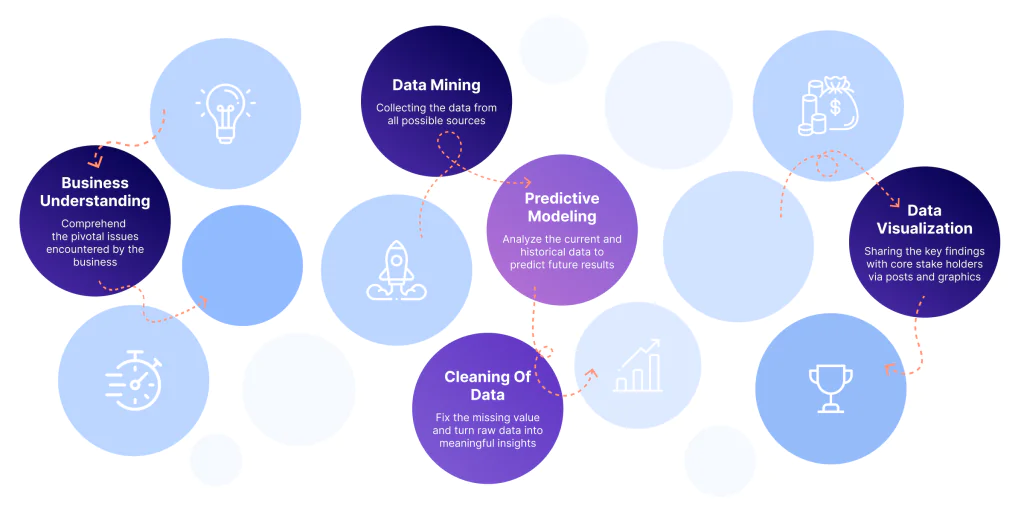Table of contents
Data science services are fast becoming the most in-demand type of business service. It’s because business owners understand that it’s impossible to succeed in modern extremely competitive markets without having an extra edge. Data analytics is the most effective way to get that edge. But it’s also important to understand that it’s a highly complex subject. So, any company that wants to get valuable insights needs to know exactly how data mining and analytics work.
Modern data science services are based on a methodology called CRISP_DM, which stands for a cross-industry standard process for data mining. It’s a cycle of processes that allows data analytics professionals to set and achieve goals. This process can be ongoing, continuously circling back to the first step and setting new goals as the project grows.
Data Science Services Breakdown: CRISP_DM Methodology
Business Understanding
The primary task of the data professional at this stage is to define exact project goals. The goal is to develop a deep understanding of the client’s needs and requirements. Business understanding goes hand in hand with project planning.
This step is crucial because building a strong foundation of business understanding is imperative before you start data mining. The process goes like this:
- Understand the client’s business objectives and how they can be achieved.
- Perform a thorough assessment of the situation by analyzing available resources, requirements, risks, contingencies, costs, and benefits.
- Define exact goals for the data mining process that correlate with the project goals.
- Create a detailed plan that describes each phase of the project and lists all necessary tools and technologies.
Data Understanding
The data understanding phase enhances the previous by defining the data sets needed to accomplish the client’s business goals. Data scientists need to complete four tasks at this stage.
- Collecting initial data and loading it into analytics tools.
- Examining the data and documenting its properties as required.
- Exploring the data: query, visualize, and determine relationships between separate pieces of data.
- Verifying the data quality and documenting it.
Data Preparation
Data preparation is the most time-consuming task in the entirety of data science services. It takes up about 80% of the data professional’s time working on a project. The quality of preparation is the crucial factor that defines analytics accuracy. This stage consists of five tasks:
- Choosing data sets that need to be used and documenting reasons for these choices.
- Cleaning the data: correcting, imputing, or removing erroneous values.
- Constructing data by deriving new useful attributes.
- Integrating data by combining multiple data sets from different sources.
- Formatting or reformatting data as necessary.
Modeling
Surprisingly, data modeling often takes the least amount of time among data science services. However, it can’t be completed without the lengthy preparation of the previous step. During this stage, data scientists create and assess models until they find the one that’s ‘good enough’. However, the entire CRISP_DM process must go through several iterations so the end model is ‘the best that could be’.
The modeling process consists of four steps:
- Choosing modeling techniques, for example, which algorithms to use.
- Creating a test design for modeling.
- Building models.
- Assessing each model and comparing them against each other based on test design domain knowledge and success criteria that are set at the beginning.
Evaluation
The evaluation stage is similar to the model assessment step of the previous stage. However, the evaluation goes deeper and considers not the technical aspects of the model but how it meets the business’ needs. The evaluation consists of three integral steps:
- Evaluating the model results based on business success criteria defined in project requirements.
- Reviewing the work to make sure nothing was missed. The findings are summarized, corrected if necessary, and documented.
- Making decisions about the following steps based on the collected data. There are three choices: deployment, further iteration, or initiating new projects.
Deployment
The project requirements define the exact process of deployment. It can differ greatly from generating a report to establishing a repeatable data mining process. At this stage, the customer must be able to access and use the model’s results. To that end, data science service providers must complete several steps:
- Create and document a deployment plan.
- Develop a plan for model monitoring and maintenance, depending on project requirements.
- Develop a final report that summarizes the entire project and includes a presentation of data mining results.
- Review the whole project, determining what went well and what could have gone better to develop plans for future improvements.
How Data Science Services Help Businesses
The primary purpose of data science services is to help the decision-making process of the business. Different types of data analytics can provide a variety of predictions that clients can use for development and growth. It’s also invaluable for risk assessment and decisions about expanding to new markets.
Data analytics works best when combining AI’s ability to process vast masses of information and human intelligence that can see the best ways to implement data mining results. If you want to find out how this works and what value your business can get from analytics, contact our data science team for a free consultation!





